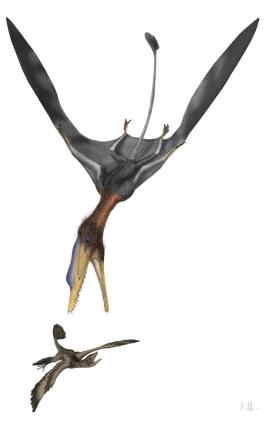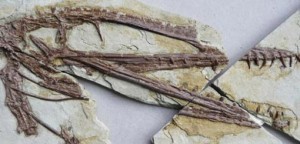Pterosaur Transitional Fossil – Is Darwinopterus Evidence of Rapid Evolution
Darwinopterus – A Transitional Pterosaur Fossil
Pterosaurs may have quickly evolved forms to take advantage of a new food source – flying theropods like Microraptor.
One hundred and sixty million years ago the skies of north eastern China were filled with primitive feathered dinosaurs that flapped awkwardly from tree to tree. These early aviators, descendants of small, meat-eating, bipedal dinosaurs had perhaps evolved flight feathers to escape from larger ground based predators or to exploit an environmental, arboreal niche.
Pterosaurs
However, pterosaurs, those aerial masters of the skies, whose ancestors had taken to the wing some seventy million years earlier, may have quickly evolved forms to take advantage of this new food source of flying theropods. At least that is what can be speculated from the research and published papers of a joint Chinese and British team of scientists as they published their work on Darwinopterus. Darwinopterus may be a transitional fossil between the long-tailed rhamphorhynchoids and the later, short-tailed pterodactyloids.
An Artist’s Impression of Darwinopterus

Picture credit: Mark Witton University of Portsmouth.
Darwinopterus
The illustration depicts Darwinopterus attacking a small bird-like creature, an ancestor of modern birds, a flexible neck combined with the curved, sharp teeth in the jaws of this raven-sized pterosaur seem ideally suited to grabbing hold of small prey. Whether this animal hunted on the wing is speculation.
The joint Chinese and British based team of palaeontologists have published their work on this 160 million-year-old Pterosaur in the scientific publication the “British Journal Proceedings of the Royal Society B”, the “B” stands for Biology. In total, more than 20 individual fossil specimens of this pterosaur have been found. This new type of flying reptile has been named Darwinopterus modularis, to honour the 200th anniversary of the birth of Charles Darwin and the 150th anniversary of his ground-breaking work on the theory of evolution – “The Origin of Species by means of Natural Selection or The Preservation of Favoured Races in the Struggle for Life”.
Darwinopterus modularis
The species name modularis meaning “composed of interchangeable units”. This alludes to the fact that this pterosaur has traits of both primitive long-tailed rhamphorhynchoids and parts of its anatomy more closely associated with the more advanced, later pterodactyloids. These specimens could be termed transitional fossils, capturing an example in the fossil record of one type of flying reptile, evolving into a different form. It is as if a sculptor has created a whole creature, a sort of prehistoric, flying chimera from various parts of other genera. One has to be careful about this, as there are several instances of composite fossils originating from China, perhaps most famously Archaeoraptor.
Archaeoraptor turned out to be an elaborate fake. Instead of proving to be a transitional fossil form between theropod dinosaurs and the first birds, it was simply pieces of at least two different fossils stuck together – it fooled the National Geographic Society.
A Close up of the Skull and Jaws of Darwinopterus
Picture credit: Lü Junchang (PA)
Darwin’s Theory
Interestingly, one of the arguments put forward by scientists in support of the idea that all species were fixed and immutable, before the publication of Darwin’s theory, and indeed an argument that was used long after Darwin had written and published his 1859 work, was that the fossil record did not show many transitional species.
The fossil record, as Darwin admitted himself was very incomplete. The beautiful argument put forward by the likes of a number of eminent American palaeontologists later in the 19th century, for the evolution of the horse was not available to Darwin at the time of his writing of his book on natural selection. In the famous volume – “The Principles of Geology” written by the English geologist Sir Charles Lyell , a tremendous influence on Darwin himself, it was written:
“There is no foundation in geological facts for the popular theory of successive development of the animal and vegetable world, from the simplest to the most perfect forms”.
Commenting on this new discovery, Dr David Unwin of the University of Leicester stated:
“Darwinopterus came as quite a shock to us. We had always expected a gap-filler with typically intermediate features such as a moderately elongated tail — neither long nor short — but the strange thing about is that it has a head and neck just like that of advanced pterosaurs, while the rest of the skeleton, including a very long tail, is identical to that of primitive forms.”
Bursts of Evolution
The long tail can be seen at the bottom of the slab on some of the fossil image. The investigators, led by Junchang Lu of the Institute of Geology in Beijing, believe that pterosaurs went through bursts of evolution characterised by swift changes to groups of features. They have postulated that the head and neck evolved first, followed later by the body, tail, wings and legs.
A sort of sequence of rapid evolutionary jumps. It can be speculated as the competition between predator and prey escalated in the air, the prey animals; the flying theropods were under a great deal of evolutionary pressure to adapt quickly and evolve into more efficient flying forms. This competition may have speeded up the evolutionary flight path (excuse the pun), of modern birds.
For replicas of pterosaurs and feathered theropods, take a look at the Safari Ltd model range: Wild Safari Prehistoric World.


